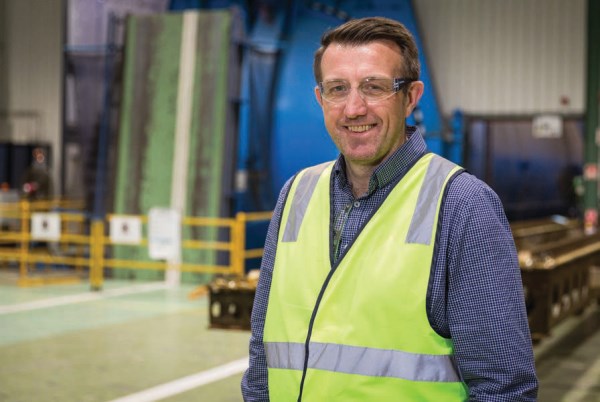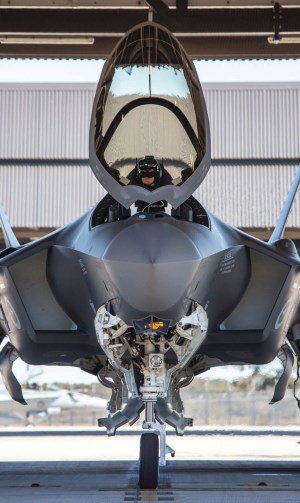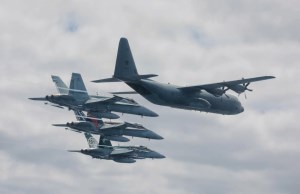APDR Mar 2021 | QUICKSTEP CEO MARK BURGESS IN CONVERSATION WITH APDR EDITOR KYM BERGMANN FOR RAAF’S 100TH BIRTHDAY (partica.online)QUICKSTEP CEO MARK BURGESS IN CONVERSATION WITH APDR EDITOR KYM BERGMANN FOR RAAF’S 100TH BIRTHDAY
Quickstep CEO Mark Burgess (Quickstep photo)APDR Mar 2021 (partica.online)
Kym Bergmann: It’s very appropriate to have this interview for this particular edition, so let’s start with a rundown of the RAAF platforms that you are involved with.
Mark Burgess: Obviously the F-35 program represents a significant chunk of our production – in fact at the moment it’s about 65% of what we make. As well as F-35 production we can also now add sustainment. The build of F-35s might continue for another 15 years – but supporting that fleet will be an activity for us that will last more than 40 years.
Having acquired a composites MRO capability from Boeing Defence Australia in November last year – located at Tullamarine – that gives us a multigenerational repair and support business. It’s our intention to offer depot level composite repair from that facility for several types of aircraft.
For C-130Js, we are the global sole source supplier of the trailing edge wing flaps on those aircraft. While only 25 new aircraft are being built per year, there are hundreds of them in service around the world. We expect not only to be repairing flaps but potentially other parts of the aircraft as well – not only for the RAAF but also potentially some of the regional operators.
On top of that, we have had a growing relationship with Boeing on the manufacturing side – and we now provide composite parts for F-15s and F-18s. Many of these are legacy out of production parts, which are increasingly difficult to source in the US because the industrial base has moved on. However, for us it’s an opportunity to earn our spurs and show Boeing what we are capable of, as well as earning a dollar.
Regarding Hornets, we supply parts to both the Classic and Super Hornet fleets. When you combine this with the new F-15X it looks like a healthy pool of work. We have even been involved with older AV-8Bs in service with the US Marine Corps.
If you include Quickstep Aerospace Services – that’s the MRO facility I referred to – that facility has done work on Classic F-18s as well as Boeing’s family of military derivatives of commercial aircraft, such as 737 BBJ; Wedgetail AEW&C and P-8A Poseidon. We hope to be doing more work in that area, as well as CH-47 Chinook helicopters.
The facility is qualified to do work on Airbus A-330s – both commercial and the RAAF’s KC-30A Multi-Role Tanker Transports. Historically, when Boeing owned the business they were Boeingcentric – and that was coupled with an unwillingness of other OEMs to work with them, because of the suspicion and rivalry that tends to exist between big manufacturers. This was part of our rationale for taking over the business – we are genuinely platform agnostic and can open up a wider range of business opportunities.
A Royal Australian Air Force F-35A Lightning II aircraft return to base after completing a mission during Exercise Lightning Storm at RAAF Base Williamtown. Credit: CoA / Melina Young
We are currently speaking with Northrop Grumman about doing some work on C-27J aircraft, which have some sustainment issues.
To return to F-35s – as well as manufacturing new components, we also expect to stand up APAC depot capability at that MRO facility.
To this we can add work coming up in the entire unmanned and remotely piloted space. For example, we are teamed with General Atomics for the RAAF MQ-9B program – and we would like to be the regional composite support organisation for that platform. We have been asked to engage with Northrop Grumman about the possibility of doing some work on MQ-4C Tritons – an aircraft that makes extensive use of composites.
As well as that, we also have something called 21J approval, which allows us to design our own repair schemes and upgrade and modification packages. One of the very encouraging things in Australia is that the ADF is prepared to qualify and approve their own modifications and upgrades – and that opens the way to more repair and modification work.
In turn, that allows Quickstep to supply back in to the US as a trusted ally and from a country with zero political risk to offer to support their aircraft in this region and in the US. There is also a chance that we will be able to export products for USN Classic and Super Hornets. To that we can add the possibility of US CH-47 Chinook and AH-64 Apache helicopters, where there is a large backlog of repair work. The Australian government is helping us offer those services to the US to provide them with surge capability.
The US Department of Defense seems interested in that concept because it adds to operational availability through using the services of close allies to provide sustainment services that are either in short supply or are no longer available. We have just acquired an amazing capability at Tullamarine that can do that sort of work on Boeing and non-Boeing platforms alike.
Q: On the issue of replacing old parts made out of metal with new ones from composites, how do you go about clearing the various regulatory hurdles?
A: This is the area where there are really interesting opportunities from the Australian perspective. Under our Department of Defence regulations, we can design the modification and then in another part of the process have it approved as being airworthy. A good example is the work that has been done installing the Ka-band SATCOM on RAAF C-130Js.
It’s a great example where Australia has done its own thing – a pioneer nation in certifying a Ka-band solution on a C-130J anywhere in the world. The work has been done independently and at a very reasonable cost.
This looks to be an approach that the RAAF is interested in for other areas because sometimes it’s easier working locally than with the OEM or the US DoD. I see another range of opportunities there as well and what that opens up for further growth and the development of Australian sovereign capability.
Q: Composites have a good reputation for durability, so how much support and repair work is there?
A: The strategy that Quickstep is following is that Australia has relatively modest sized fleets of aircraft. They have a high level of capability, but small numbers of aircraft. For example, if we perform work on a Super Hornet, it is only if the business case makes sense – but that business case changes completely if you look at not only the 36 RAAF jets but include the USN, which has more than 600 of them.
The same applies for military derivatives of commercial aircraft. We plan to do a lot of work for both Qantas and Virgin on their Boeing 737 aircraft – thrust reversers, engine nacelles, landing gear doors – and those items are almost identical to those found on BBJ, Wedgetail and Poseidon.
Similarly, for the F-35s – we have been assigned not only to support the RAAF aircraft but generally all of them in the APAC region. This means we may also cover US deployed forces, Japan, South Korea and Singapore – which of course is a much larger fleet and gives us a significant aggregation of demand.
F/A-18A Hornets A21-39, A21-23 and A21-07 from No 77 Squadron conduct air-to-air formation flying with a C-130J Hercules from No. 37 Squadron off the coast of Newcastle. Credit: CoA / David Gibbs
There will always be cases were things have to go back to the OEM and in other cases there is only sufficient work to support one location globally. Having said that, what we are seeing is that there is a lot of work going offshore that could realistically be done in Australia – at the same, or lower, cost.
Q: Regarding regional F-35 support work – has any of that started or is it in the future?
A: We are partnered with Northrop Grumman for what is called Repair Group C – which is basically all of the composites. The international Joint Program Office have assigned that work to Northrop and Quickstep – but that’s an assignment, not a contract. We are probably at least 18 months away from any work at the depot level.
In the near term the focus is on supporting the Hornets – including the Growlers – and we are hoping to make inroads into military helicopters. We have had discussions with both Sikorsky and Airbus that are very productive. There is massive latent demand, either because it wasn’t put into Australia in the first place or has gradually eroded away.
We have to turn that latent demand into actual purchase orders and the like – but we have the fixed infrastructure, which is a vital ingredient. With the facility, the equipment and the people already here, the incremental cost of acquiring the licenses and specific tooling is relatively modest. It’s not like building new parts from scratch where large capital investments need to be made. In our case, these additional investments might be in the hundreds of thousands of dollars, which can be amortised over 20 years of maintenance activities.
We have a strong appetite to invest in the business and we see it as an engine of growth. It was a very small part of an extremely large Boeing organisation and we have already saved it from closure by acquiring it. It is an integral and high profile part of our business that would never have been possible under the previous ownership structure.
Q: Looking again at F-35s in the region – many countries have high technology industrial bases. What’s your sales pitch to them to let Quickstep do the work rather than them find a local entity?
A: There are several levels to that. Firstly, if the JPO has already assigned the work to an Australian company it means in essence that they want all work to go to that company. Now, that’s not the same as the Japanese, Koreans and Singaporeans automatically agreeing – but Quickstep can offer a much faster turnaround time and a lower cost solution based on the aggregation of demand factor.
Our infrastructure is already paid for, so it’s not necessary for another government to replicate the existing investment. On top of that, there are various national relationships involved such as the Quad, the Five Power Defence Agreement and so on that support the concept of working together as trusted allies rather than individually.
Of course, we have to offer compelling prices and delivery schedules. Also we treat all our customers as being equal, so everyone receives the same treatment in terms of priority and timeliness. For us a contractual commitment is exactly that – and we will meet it without any favouritism. For some technologies and services countries might wish to retain sovereign control, but in our field of composites I don’t see this as being a big issue.
APDR Mar 2021 (partica.online)
PODCAST: Harnessing local capability to realise growth potential— Mark Burgess, managing director and CEO of Quickstep - Defence Connect
Quickstep's carbon fibres - Eureka Report
Aerospace | National Industry Insights Report (aisc.net.au)
ADBR Mar-Apr 2021_Realview (partica.online)
Fishermans Bend Innovation Precinct and the future of advanced manufacturing, engineering and design
Carbon Fibre Australia: A Look At R&D, Industry, And Innovation - INNOVYNC
- Forums
- ASX - By Stock
- Ways for QHL to 25cents
APDR Mar 2021 | QUICKSTEP CEO MARK BURGESS IN CONVERSATION WITH...
-
- There are more pages in this discussion • 60 more messages in this thread...
You’re viewing a single post only. To view the entire thread just sign in or Join Now (FREE)
Featured News
Add QHL (ASX) to my watchlist
 (20min delay) (20min delay)
|
|||||
|
Last
18.5¢ |
Change
-0.010(5.13%) |
Mkt cap ! $13.26M | |||
| Open | High | Low | Value | Volume |
| 19.5¢ | 19.5¢ | 18.5¢ | $7.114K | 37.36K |
Buyers (Bids)
| No. | Vol. | Price($) |
|---|---|---|
| 6 | 109463 | 18.5¢ |
Sellers (Offers)
| Price($) | Vol. | No. |
|---|---|---|
| 20.0¢ | 6813 | 1 |
View Market Depth
| No. | Vol. | Price($) |
|---|---|---|
| 5 | 84463 | 0.185 |
| 3 | 53824 | 0.180 |
| 1 | 17000 | 0.175 |
| 1 | 5500 | 0.170 |
| 2 | 23336 | 0.150 |
| Price($) | Vol. | No. |
|---|---|---|
| 0.200 | 6813 | 1 |
| 0.210 | 4692 | 2 |
| 0.215 | 4166 | 1 |
| 0.220 | 32395 | 3 |
| 0.225 | 3533 | 1 |
| Last trade - 15.23pm 03/05/2024 (20 minute delay) ? |
Featured News
| QHL (ASX) Chart |














